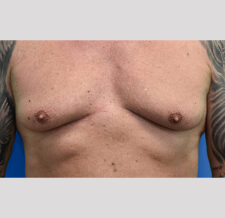When Should I Consider Treatment For Gynecomastia?
If you feel self-conscious about the size or appearance of your chest due to gynecomastia, this treatment may be able to help you improve your confidence and allow you to feel more comfortable on a day-to-day basis. Many patients suffer from low self-esteem that makes life difficult, and certain activities may be avoided if they require a man with gynecomastia to go without a shirt. For treatment, it’s important for you to be in good overall shape and to have reasonable expectations for the outcome.
Boys and men who struggle with the development of breast tissue may present as candidates for male breast reduction surgery. The breast itself comprises both fat and glandular tissue, and may be tender. It is also important that the individual be a non-smoker (for at least two weeks prior to surgery), of stable weight, and in good health. Dr. Goldberg will walk you through your customized procedure to help you understand what can be accomplished.
What is Male Breast Reduction?
Male breast reduction is an elective surgical procedure performed to flatten the chest and provide a more masculine look. This is done by extracting fat, removing excess breast tissue, and addressing loose skin on the chest. Surgery can also help resize or recontour the nipples if necessary. The procedure may include liposuction, nipple revision, surgical excision, or some combination of all three techniques. Whether a patient’s gynecomastia is caused by glandular tissue or isolated fat, the treatment plan for male breast reduction is personalized according to each person’s unique needs. This procedure is the only treatment for gynecomastia capable of contouring the chest with long-lasting and natural-looking results. Our before-and-after photos of male breast reduction results can illustrate the types of outcomes you can expect following the procedure. If you believe this enhancement aligns with your overall goals, this may be an indication that you can benefit from male breast reduction.
How Is Male Breast Reduction Performed?
In order to assess your condition thoroughly, Dr. Goldberg will likely recommend that you receive a medical examination prior to surgery, including an MRI or mammogram. The procedure itself takes approximately two hours, and is conducted under general anesthesia for large tissue removal; local for minor removal.
If the MRI or mammogram shows that the breast is composed mainly of glandular tissue, Dr. Goldberg will probably select surgical excision to conduct your breast reduction. During surgery he will make an incision under the arm or at the areola. The glandular tissue and fat will then be removed with a scalpel.
If testing reveals that the breast is composed of both fat and glandular tissue, a combined approach may be necessary. In liposuction, the plastic surgeon inserts a cannula, or thin tube, into the incision to dislodge the fat deposits. The fat is then removed by way of a vacuum device. Sometimes only liposuction is needed, in which case, a small incision is made under the arm or at the areola.
What Is Recovery From Male Breast Reduction Like?
Patients should be able to return home the same day as the surgery. Some discomfort, as well as swelling and bruising, are common after the procedure, and we will provide medication to ease your symptoms. You may be able return to work as quickly as one week following breast reduction surgery. Strenuous exercise should be avoided, however, for approximately three weeks, although walking and light activity are encouraged. Once you have recovered, it is important to remember that regular exercise and a healthy diet are necessary to ensure lasting results. You should have a good idea of the final results after a couple of months.












